The number of homeless men and women seems to have increased over the past two years, according to research undertaken for the city.
As the city looks to create a co-ordinated system to provide services and referrals for homeless men and women, Ron Van Wyk of the Mennonite Central Committee has led a research project to better understand prospective clients of such a system.
And while that research hasn’t included a formal count, Van Wyk – who co-ordinated the most recent Fraser Valley Regional District’s homeless count in 2014 – said anecdotes suggest the area’s homeless population has risen in the time since.
“We are finding that front-line workers are seeing more faces, they’re seeing new people,” Van Wyk said. “The responses are that there are more people than the 150 we counted in 2014.” He added that that figure is viewed as an undercount of the true number of homeless men and women. The next homeless count is slated to take place next year.
While the research has unsurprisingly found many of those on the street have addiction or mental health issues, it also confirmed a finding from 2014 that a higher percentage of those living on the street in Abbotsford are chronically homeless than elsewhere in Canada.
Van Wyk said that as many as 30 per cent of those in Abbotsford seem to be stuck in long-term homelessness, whereas other areas of Canada have reported figures between 10 and 20 per cent.
Van Wyk said researchers have also heard that the city hoped to create is unlikely to solve homelessness without significant additional resources.
“The housing options out there that can provide long-term housing and support to people is not there,” he said. “We can develop a skookum co-ordinated intake and referral system, but if the resources in terms of supportive housing, mental health service, addiction services … is not there at an adequate level, then you’re still hooped.”
